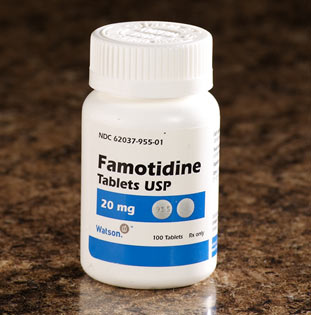Top Class Actions’s website and social media posts use affiliate links. If you make a purchase using such links, we may receive a commission, but it will not result in any additional charges to you. Please review our Affiliate Link Disclosure for more information.

Stevens Johnson Syndrome (SJS) is an extreme skin reaction which can quickly turn into Toxic Epidermal Necrolysis (TEN), and then turn fatal. It burns off a person’s skin from the inside out, but often starts at what appears to be a harmless rash. The rash turns into blisters, often collecting at wet regions such as the groin and eyes, and at this point a person must be treated in a burn unit.
The current Famotidine side effects listed on the label include nausea, pneumonia, hypotension, and fever. There is no mention of SJS, even though a recent collection of studies of over 20,000 people suggests that it should be listed as a Famotidine complication.
The collected study includes 20,885 people who were prescribed Famotidine and considered the amount of time a person took the drug, the age and gender of patients, how severe their SJS was, how long it took them to recover (if they did), and potentially related drugs and conditions excepting Famotidine. The figures were provided largely by the U.S. Food & Drug Administration (FDA), which keeps a close watch on Famotidine complaints as well as thousands of other complaints by patients.
Since 1977, 200 million drug outcomes have been recorded by the FDA. As far as SJS goes, the most common victims are those with epilepsy, high blood pressure and convulsion issues, but anyone can become a victim. Some people as young as two years old have died of SJS, which is almost always caused by an adverse drug reaction. It is, after all, an allergic reaction, and safely taking a drug previously doesn’t mean a person is immune.
As of December 2013, almost 21,000 people have reported that they experienced complications from Famotidine side effects. Of those people, 362 (or 1.74 percent) had SJS. The most cases of Famotidine SJS were reported in 2008 with 45 patients, followed closely by 38 people in 2012 and 31 people in 2006. The numbers have been steadily increasing since Famotidine came on the market in 1997, when only two people reported getting SJS from the drug.
Just like every other instance of drug-induced SJS, the vast majority of people experienced this skin reaction in the first month of taking Famotidine—in fact, 82.98 percent of people got SJS from Famotidine in the first month. The numbers slowly trickle downward from there.
Just 9.22 percent of people got SJS within one to six months of starting the drug, and 4.26 percent got it in two to five years from starting it. While the latter numbers are low, they showcase that SJS can actually strike at any time. Some people have taken a drug for years with no adverse effects, and then suddenly their body reacts strongly to it. This delayed reaction can lull a person into a false sense of security, and make them think the drugs they’ve been taking for years aren’t to blame for their sudden rash. SJS is also largely misdiagnosed by physicians since it’s still relatively rare.
The SJS Statistics
When it comes to gender, SJS doesn’t play favorites and the victims are pretty evenly split. While 56.76 percent of Famotidine SJS victims are male, 43.24 percent are female—however, this may also be because more men are prescribed drugs for indigestion than women. Most people who were victims were over the age of 60 at 57.02 percent, followed by those 50-59 at 24.94 percent, with the numbers slowly trickling down with each age category. Sadly, 1.78 percent of Famotidine sufferers were aged newborn to one year old.
When it comes to “severity,” the FDA offers least, moderate, severe and most severe categories. A full 100 percent of Famotidine sufferers fell into the severe category. In total, 86 people (or 23.76 percent) were prescribed the drug for hypertension, 61 (16.85 percent) for a gastric ulcer, 35 (9.67 percent) for constipation, 30 (8.29 percent) for an ulcer, and 30 for gastritis. The most popular drugs co-used by patients were Norvasc with 58 people (16.02 percent), Prednisolone also with 58 people, Lasix with 53 people (14.64 percent), Clarithromycin with 52 people (14.36 percent) and Atarax with 50 people (13.81 percent).
Were You Diagnosed with SJS?
If you or a loved one took Famotidine or another medication and developed Stevens Johnson Syndrome (SJS) or toxic epidermal necrolysis (TEN), you may be eligible to take legal action against the drug manufacturer. Filing a Stevens Johnson Syndrome lawsuit may help you obtain compensation for medical bills, pain and suffering and other damages. Learn more and obtain a free case evaluation at the Stevens Johnson Syndrome (SJS) Class Action Lawsuit Investigation.
ATTORNEY ADVERTISING
Top Class Actions is a Proud Member of the American Bar Association
LEGAL INFORMATION IS NOT LEGAL ADVICE
Top Class Actions Legal Statement
©2008 – 2024 Top Class Actions® LLC
Various Trademarks held by their respective owners
This website is not intended for viewing or usage by European Union citizens.















8 thoughts onFamotidine Linked to Stevens Johnson Syndrome (SJS)
I only took this medication for 3 days and it burned my face from the inside out. It burns my collarbone and chest. The way the burn looks like a butterfly shape across my face and also around my mouth and now it left me with scars. I went to Urgent Care and they stated they have never seen these type of burns that a medication would do. I have never had a sunburn a day of my life and the reason for that is I am Italian we don’t burn also this is a new medication that the gastrologist had put me on and I’m finding out now that this medication was discontinued on the medication through the drug and food list so I shouldn’t have never been on this medication in the first place because their lack of incompetent I’m left with scars on my face chest and collarbone. I am peed off.
My dr thinks I’m having an allergic reaction to this medicine right now. Very itchy welt like rash after starting it. Been sick for a year with know diagnosis…this makes me wonder.
My mother was taking this medication and developed SJS, she developed a severe rash her lips were so swollen that they turned inside out, she was admitted to the hospital for a few days. About a year or so later she was diagnosed with pancreatic cancer in September 2022 and passed away in November 2022. No family history of cancer either.
Now i understand why i feel light headed and i been diagnosed with kidney problems.
Why am I taking famotidine for allergies for 2 years now
I took Pepcid for a year or more. I developed breast cancer in 2013 and Had a mastectomy. I got cellulitis following surgery. No cancer on either side of my family prior to this.
I have been taking Famotidine
I feel very weak 2 hours after I take it, feel like I ‘m going to faint.
I will stop it today.
Get checked for orthostatic hypotension.